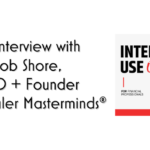The topic of Social Security distribution planning has been a hot topic for advisors and wholesalers alike.
But what about the intricacies of retirement health care costs and the impact on sound financial planning?
Our guest offers thought provoking insights and ideas for you to bring to your advisors.
Keynote Speaker Peter Stahl brings over 25 years of experience in the financial services industry.
Peter Stahl founded Bedrock Business Results, LLC, in 2012 as a training and consulting firm designed to help financial advisors and their clients understand health care challenges during retirement, equipping them to provide solutions. With a seasoned, results driven style, he makes navigation through a complex and ever-changing health care landscape comprehensible to all. The foundation of his exceptional communication and presentation skill set is the core product proficiency that Peter brings in insurance, mutual funds, annuities and retirement plans.
He began his career at Putnam, and later led teams to industry-leading market penetration as well as individual performance at Hartford Financial Services.
He has been a Certified Financial Planner (CFP) since 1997 and also holds the Certified in Long Term Care (CLTC) and Chartered Mutual Fund Counselor (CFMC) designations.
Connect with Clients and Think Outside the Box – Health Savings Accounts
Concern over retirement health care costs now ranks as a top concern among pre-retirees. Clients, especially those considered affluent, are taking action to plan and prepare. Americans with high incomes ($175,000+) are significantly more likely (47%) than lower earners to have specific plans to cover healthcare costs (How Working Americans View Healthcare costs in retirement; Sun Life Financial May 2011). It is therefore not surprising to see the tremendous growth of the number and size of Health Savings Accounts. As of December 2015 there were approximately 16 million health savings accounts with $30 billion in assets (Devenir).
Clients do need advice in order to maximize the potential of their Health Savings Account (HSA). I will provide a short description of these accounts and then provide five ideas every HSA owner should consider.
- HSAs are only available in conjunction with a high deductible health insurance plan. You or possibly your employer, place money into your HSA to be used for health care expenditures not covered by insurance.
- Any amount you contribute (up to the contribution limit) is tax deductible from federal and most state taxes (exceptions are Alabama, California, and New Jersey). Contributions are not counted toward taxable wages for FICA taxes.
- There are no earnings limitations to prohibit HSA contributions like the ones that exist for IRAs.
- Earnings in an HSA accumulate free from federal taxation and free from most state taxation.
- Unused balances rollover from one year to the next.
- Accounts continue to belong to you if you leave your employer.
- Distributions for qualified medical expenditures are tax-free.
- Withdrawals for non-qualified medical expenditures are subject to ordinary income taxes and if you are under age 65, a 20% penalty.
2017 contribution limits:
- HSA with Single Person Health Coverage: $3,400
- HSA with Family Coverage: $6,750
- A $1,000 catch up provision is available for those age 55 years and older.
There are five ideas you should discuss with your clients who utilize HSA accounts.
- Do not touch your HSA account until retirement. Most individuals will experience their greatest health care costs during retirement, hence the great concern mentioned above. Alleviate this concern by accumulating meaningful assets earmarked for retirement health care costs in a tax favored setting. This will require some basic financial planning. An emergency fund (most planners recommend 6-12 months of living expenses in a liquid account) may be needed to handle unexpected medical bills.
- Invest the HSA. This will involve making sure your HSA custodian offers a reasonable number of investment choices. If not, you can transfer your account to a custodian that does. Remember that the HSA is your money. Depending on your age, a 10 to 15 year time horizon for the HSA account should be sufficient to weather short-term market volatility as you dollar cost average contributions each year.
- Spouses covered under a family plan should split their HSA into two accounts as they approach age 55. This will allow each spouse to use the $1,000 catch up contribution.
- Save medical receipts from each year you make HSA contributions. Receipts from prior years can be used to create qualified tax-free distributions in any year.
- For those who continue to work beyond age 65 for an employer with 20 or more employees, you should consider deferring your Social Security Benefit, delaying your Medicare enrollment and continuing to fund your HSA. A full discussion of this strategy is beyond the scope of this discussion, but the increase in deferred Social Security payments, the cost savings of delaying Medicare and the added benefit of continued funding into the HSA warrant serious consideration.
Written by Peter Stahl
This information is provided as a general overview. It is derived from the Internal Revenue Code, Medicare.gov and other government publications, all subject matter sources reasonably believed to be reliable. Tax law and the laws governing Medicare/Medicaid are complex and subject to change. Clients should consult with their attorney and/or qualified tax advisor when making decisions regarding these matters.


 RIA Wholesaling Best Practices with Dennis Gallant
RIA Wholesaling Best Practices with Dennis Gallant Daily Habits of Highly Profitable Wholesalers with Laura Stack
Daily Habits of Highly Profitable Wholesalers with Laura Stack Special Podcast Episode: Six Attributes of a Long and Successful Distribution Career
Special Podcast Episode: Six Attributes of a Long and Successful Distribution Career The Impact of Change on Distribution and Wholesaling with Steven Miyao
The Impact of Change on Distribution and Wholesaling with Steven Miyao How Can Wholesalers Deepen Their Advisor Relationships? with Anne Loehr
How Can Wholesalers Deepen Their Advisor Relationships? with Anne Loehr